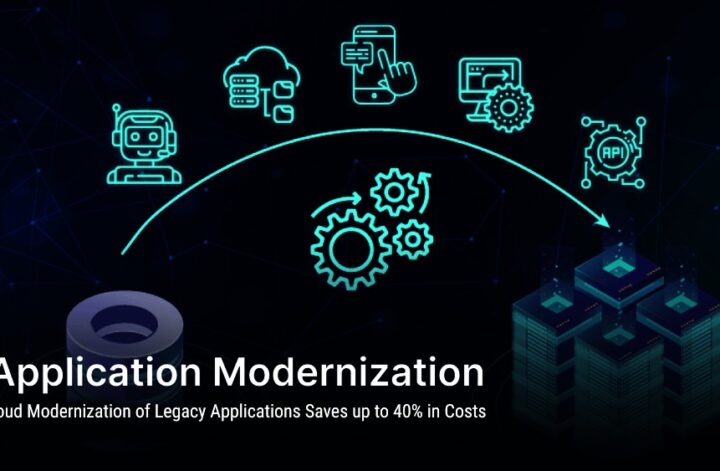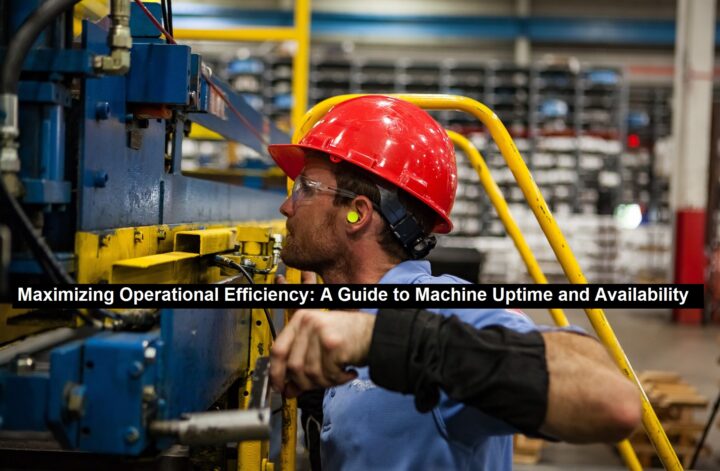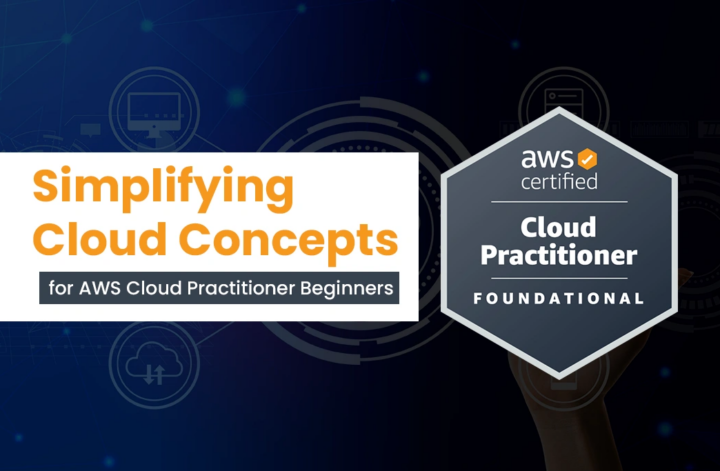Introduction
A few years ago, the Government Accountability Office (GAO) in the US identified over 10 federal IT systems that were no less than legacy and were in ardent need of modernization. Why? It was primarily because maintaining and operating them (collectively) costed approximately US$337 million annually! Vendors were either no longer providing support, they were written in extremely outdated programming languages, or were running on unknown security vulnerabilities. (source)
Clearly, the technical debt arising from maintaining legacy systems takes a significant portion of funds that could have been utilized elsewhere. However, there’s one way to minimize these financial implications— legacy application modernization.
This blog will explore how modernizing legacy apps can help you minimize operational costs:
Financial Implications of Maintaining a Legacy Application
Over time, as legacy applications get outdated, they often make you wonder: how much am I overspending in maintaining them? These can still function, but the costs can quickly add up when getting the work done. This is why, it’s essential to understand the financial implications associated with them.
- Explicit Costs
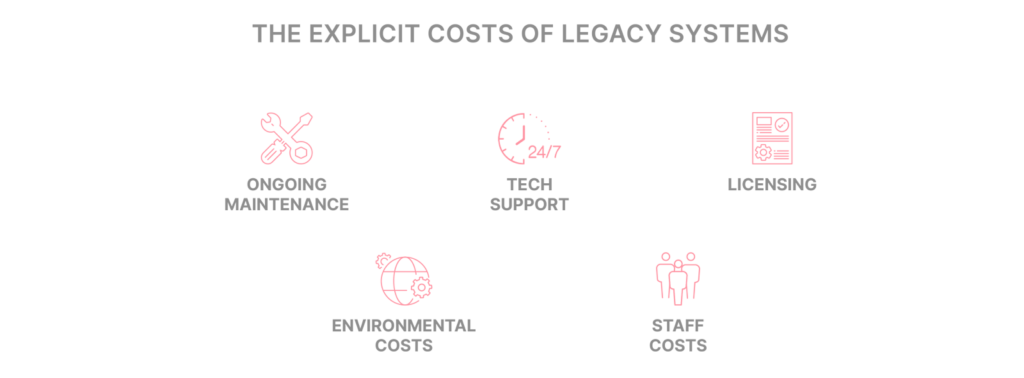
Maintaining these apps often requires steady expenses, including routine maintenance, software updates, and technical support. These costs can be substantial as many legacy applications require specialized knowledge and licenses to manage. Particularly with today’s mobile and tech-savvy workforce, finding and hiring the right people can be challenging. Moreover, regular upgrades to keep them functional can lead to further financial strain.
- Implicit Costs

The true financial effect of legacy applications often lies in the hidden costs. These systems lead to substantial downtime, whether due to technical failures or compatibility issues with other systems. Each minute spent troubleshooting or waiting for recovery ultimately results in lost productivity and revenue. Moreover, extended downtimes also risk potential security and data breaches.
Other Challenges of Maintaining Legacy Applications
Besides draining your resources, legacy applications pose several other challenges, including:
- Security Vulnerabilities: Legacy systems are more prone to cyber threats because they do not support the latest security protocols. This is particularly true in today’s time when data breaches and cyber-attacks are all over the headlines.
- Restricted Functionality: Legacy applications are often incompatible with modern technologies and newer systems, limiting their functionality and interoperability. This hinders business processes, making it difficult to implement infrastructure enhancements.
- Data Silos: These systems often operate in isolation and restricted physical environments due to their dependence on hardware. This creates data silos that impede data sharing across the organization, resulting in inefficiencies, data inconsistencies, and poor decision-making.
- Lack of Vendor Support: As in the case of GAO’s findings, many legacy systems and functions are no longer supported by their original vendors. This makes it difficult to find updates, patches, or technical assistance, leaving organizations burdened with unresolved issues.
- Performance Issues: As businesses grow and data volumes increase, legacy systems often can’t keep up with the demands. This can lead to slower performance, increased downtime, and a lack of scalability, affecting overall productivity.
The Solution: Legacy Application Modernization
The numerous legacy app challenges can be tackled with one solution—application modernization. Let’s see how:
Addressing High Maintenance Costs
Modernizing legacy applications often involves migrating them to newer technologies that require less maintenance and dedicated professionals skilled in both modern and legacy programming languages. Moreover, moving these applications to the cloud can also reduce hardware dependency as these platforms offer scalable resources without having you worry about the underlying infrastructure, further lowering maintenance costs.
Better Security
Modernizing your legacy infrastructure also means incorporating advanced security measures like multi-factor authentication (MFA), encryption, authentication mechanisms, etc. These features protect your sensitive data and ensure compliance with current security standards, significantly reducing the risk of costly data breaches.
More Functionalities
Modernized legacy applications, migrated to the latest technologies, offer more advanced features and integration capabilities. With these solutions, you can quickly implement feature enhancements and adapt to changing business requirements, fostering a culture of innovation and agility.
Breaking Down Data Silos
Modernizing legacy applications enhances data integration and sharing across your organization. Typically, this involves consolidating your data into a centralized repository accessible by diverse teams. This unified data view fosters better collaboration and decision-making, as all teams can identify trends and optimize operations based on shared insights.
Continuous Vendor Support
By migrating your legacy applications to newer technologies or the cloud, you get access to active vendor support. With modern technologies, you will have a large pool of proficient and emerging developers who are constantly innovating and improving. Moreover, when you migrate to the cloud, service providers take care of everything, ensuring your applications are secure and running.
Improving Performance and Scalability
As your business grows, so will the demands on your IT infrastructure. Modernization addresses legacy app challenges by transitioning to a flexible cloud infrastructure where you can adjust resources based on demand. This flexibility ensures consistent performance even with varying computing requirements.
Read: Subscription-based E-commerce Models: Building Recurring Revenue
Case Study: Cloud-Based App Modernization
The impact of modernizing legacy apps is just as true in the theory:
Consider Jotun, a multinational chemical supplier that achieved a remarkable return on investment when they modernized their sales applications.
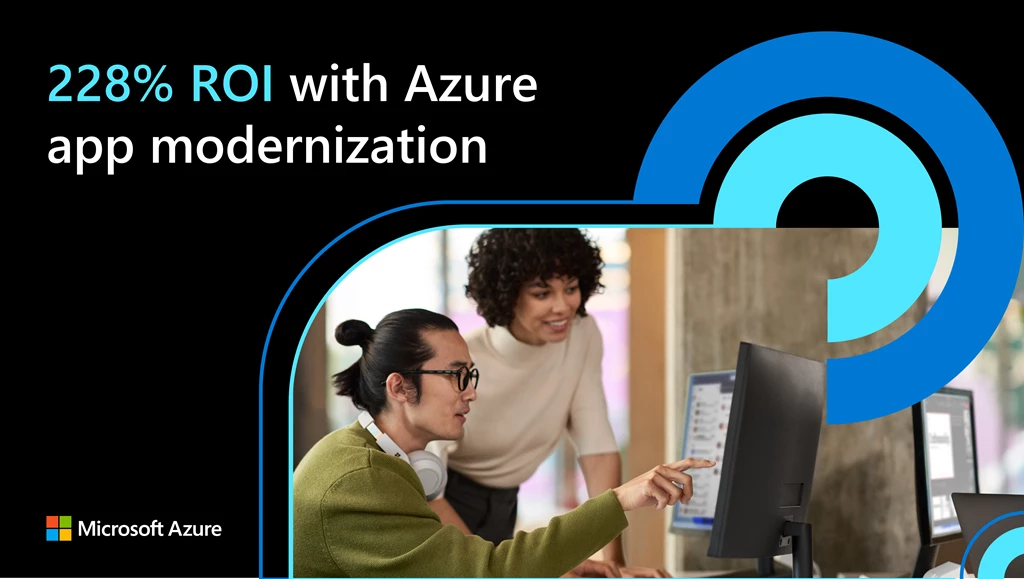
What exactly happened?
They stopped investing in their on-premises infrastructure and started modernizing their applications by migrating to the cloud using Azure App Service.
What was the result?
Cloud-based app modernization allowed them to provision their services from anywhere in the world and prioritize security features from early on in the development process via a Dev Sec Ops approach. Within just a few months, they experienced:
- A return on investment of 228% over three years, achieving payback in just 15 months
- 50% increase in the speed of application development
- 40% reduction in development-related infrastructure costs
(Source)
Considerations for Successful Legacy Application Modernization
While the benefits of modernizing legacy applications are many, being successful at it requires some considerations:
- Before getting started with the process, it’s crucial to establish your modernization goal(s)—reduced costs, improved performance, or easy maintenance.
- Take the time to evaluate your existing legacy applications and identify the systems needing urgent attention.
- Determine the right modernization approach, whether it’s partial refactoring, rebuilding, or migrating to the cloud.
- Create a comprehensive modernization and migration (if you’re moving to the cloud) plan to minimize disruptions.
- Retrain and upskill your staff in the new technology to ease this transition.
- Pay close attention to data integrity and security throughout the process.
- Post legacy application modernization, keep a close eye on performance.
- If you’re unsure about the modernization process, consider professional legacy app modernization services. These experts can make the process much easier and more efficient.
- Last, but not least, encourage a culture that welcomes change and embraces technological advancements.
Bringing it All Together
Modernizing applications is much more than moving on to newer technologies; it’s about future-proofing your business. Moving on from outdated systems that deliver sluggish performance, add on to the costs, and come with a myriad of operational challenges can save you from significant financial implications. As evident from Jotun’s experience, it can even amount to considerable cost savings and process enhancements. With a thoughtful approach and a solid modernization plan, you can also experience this transformation and see remarkable results.
Author’s Bio:
Nathan Smith is an experienced web and app developer, currently working with Techno Score- a leading web and app development company in India. As a technology enthusiast, he is passionate about sharing his web and application development knowledge through his articles.

